How Yo Make Garden Gate
This post may contain affiliate links which won't change your price but will share some commission.



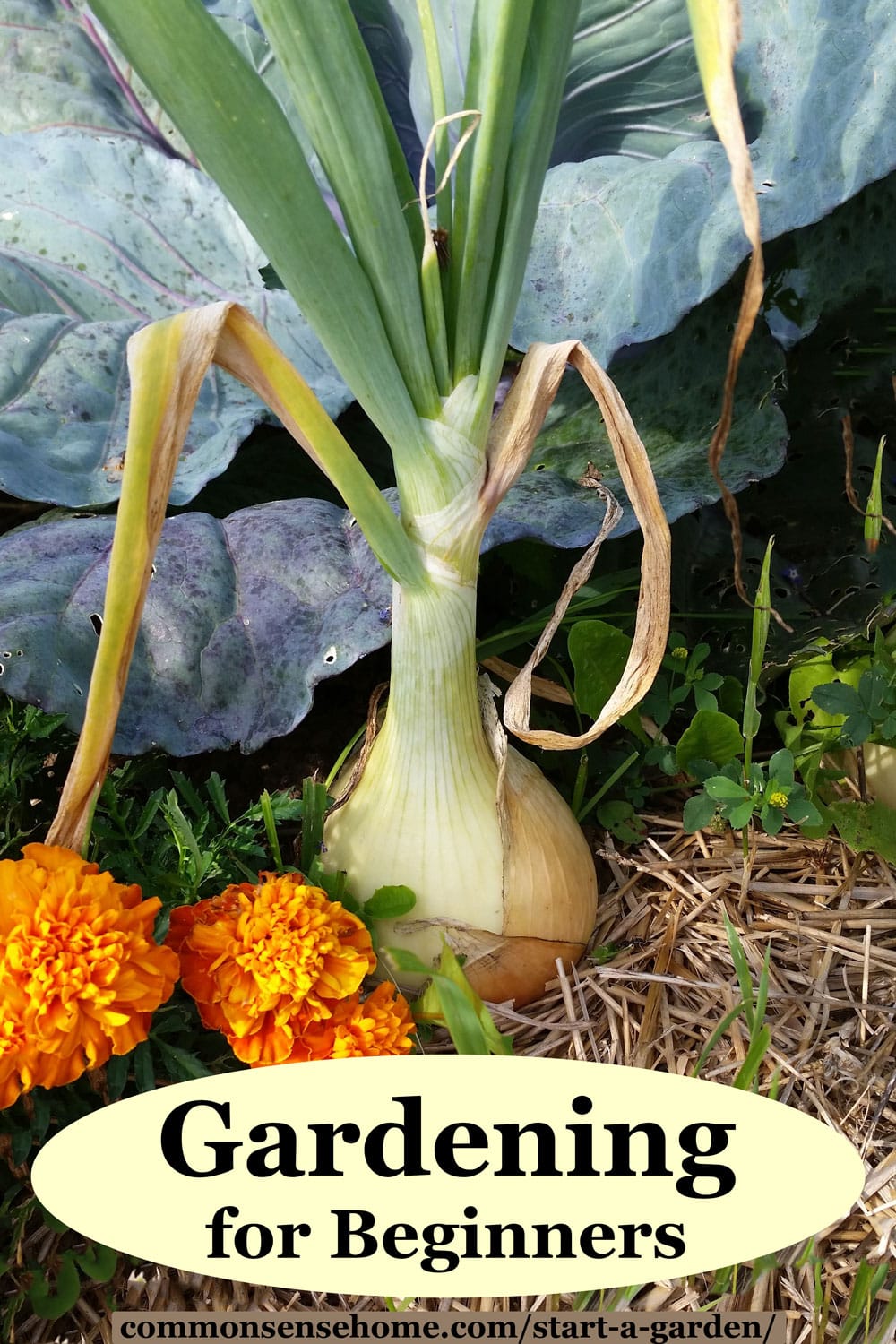
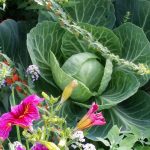
Want to learn how to start a garden, but not sure where to begin? In this post I'll cover the basics of gardening, and provide links to more detailed information so you can garden with confidence and have fun doing it. Get ready to enjoy some of the best tasting fruits, vegetables and herbs you've even eaten.

Contents
- How to Start a Garden – 10 Basic Steps
- #1 – Decide What You'd Like to Grow in Your Home Garden
- #2 – Choose a Location to Start Your Garden
- #3 – Plan Your Garden Beds
- Vertical Gardening
- #4 – Invest in Basic Garden Tools
- #5 – Test Your Soil
- #6 – Build Your Soil
- #7 – Choose the Right Seeds or Transplants
- #8 – Plant with Care
- #9 – Nurture Your Garden
- #10 – Enjoy Your Harvest
- More Gardening Information
How to Start a Garden – 10 Basic Steps
- Decide what you'd like to grow
- Choose a location
- Plan your garden beds
- Invest in basic garden tools
- Test your soil
- Prepare the soil
- Choose the right seeds or transplants
- Plant with care
- Nurture your garden
- Enjoy your harvest!
#1 – Decide What You'd Like to Grow in Your Home Garden
Rule #1 – If you won't eat a crop, don't grow it in your vegetable garden. (I break this rule for flowers. Edible or not, I like to see at least a few in every garden.) Focus on the fruits, vegetables or herbs that your family enjoys the most.
Make sure your top choices make sense for your area. Figure out your gardening zone and estimated first and last frost dates. If possible, talk to successful gardeners in your area to find out which crops grow well and which don't.
See "USDA Hardiness Zones & Your Microclimate" for a more information on how growing conditions affect garden plans.
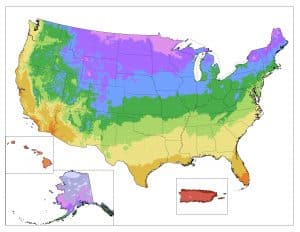

In my northern garden, crops that take over 100 days to mature or high temps are a gamble. For example, we enjoy watermelons, but I stick to varieties like Blacktail Mountain (70 days) instead of Carolina Cross (90 days). My southern gardening friend, Amber, has challenges with crops like peas, which prefer cooler temperatures, and vine crops like cucumbers, which are prone to mildew in high humidity.
If you only want a small garden, don't attempt to grow something like a giant pumpkin, which will spread over a very large area.
Do you want to plan for storage vegetables, or only enough to eat fresh? It's probably best to start your garden mainly with fresh eating in mind, but some vegetables are extremely easy to store. See The 5 Easiest Vegetables to Store for more information.
#2 – Choose a Location to Start Your Garden
Most fruits and vegetables need full sun, with a minimum of five hours of direct sunlight per day for fruiting. Greens, herbs and root veggies will grow in partial shade. Southern gardens may benefit from late afternoon shade, whereas northern gardens likely need all the sun they can get.
Think about how you will access the garden for picking, watering and caring for your plants. Out of site often equals out of mind – and a neglected garden. Avoid high wind areas and frost pockets (low areas where frost is likely to settle).
Watch out for wildlife, pet damage and children's play areas. When we first moved here, our neighbor's dog would randomly visit and dash through the garden. This was very hard on new seedlings. Now the dog is gone, but the deer and wild bunnies come to visit, so we plan accordingly.
See Keep Deer Out of Your Garden – 5 Deer Deterrent Strategies and 6 Ways to Use Garlic in the Garden for tips.
For more ideas on gardening in limited space, see "Small Garden, Big Yield – 10 Tips for a Great Harvest".

#3 – Plan Your Garden Beds
Once you know where you want your garden, decide on the type and size of garden bed(s). Raised beds are attractive and may make it easier to work in your garden, but they also dry out more quickly. In very dry areas, sunken beds can be used to gather available moisture.
Think about planting your garden in blocks or beds of plants instead of single rows. Beds should be 3 to 4 feet across – narrow enough that you can reach the center from either side. Beds should be roughly 10 feet long or less, so you're not tempted to step into the bed and compact the ground.
Within the garden beds, place plants in rows or a grid pattern. The goal is minimize walkways and maximize growing space. You only add fertilizer and soil amendments to the planting area, which saves time and money. Work with companion plants to attract beneficial insects and improve yields.
Start small, and make sure to give each plant enough room to grow. The seeds and transplants are tiny, but full grown plants can get huge. Overcrowded plants have difficulty thriving. A small, well-tended garden can produce as much or more than a large, poorly tended garden.
Rectangular or square beds are the most common, but you're only limited by your imagination and building skills. Most raised bed kits are rectangular, but you can also plant your garden in found items like old livestock water tanks or sections of drain pipe.
See "Raised Garden Beds" for more information on different types of raised beds and how to work with them.

Vertical Gardening
If you grow vertically, you can squeeze more crops into less space. The best book I've found to date on the subject is "How to Grow More Vegetables, (and Fruits, Nuts, Berries, Grains, and Other Crops) Than You Ever Thought Possible on Less Land Than You Can Imagine".
I trellis/fence or otherwise grow vertically my tomatoes, beans, peas, cucumbers, and occasionally other crops. Check out 10 Reasons to Garden Up Instead of Out for more details.
What if you have a yard with limited growing space? Consider grow bags or containers to start your garden. Self-watering containers are a lot more forgiving than terracotta flower pots, which tend to dry out quickly.
GreenStalk vertical planters are a great option to pack a lot of growing space into a small footprint. They have a tiered watering system so the whole growing area is evenly watered.
You can use the discount code "commonsense10" to get $10 off of your GreenStalk purchase. Visit the GreenStalk site here to order or learn more.

The right tools make working in your garden a pleasure instead of a chore. You don't use a butter knife to chop up raw carrots, and you shouldn't use dull or flimsy tools to work in your garden. Basic gardening equipment includes:
- Garden hoe
- Scuffle hoe
- Dirt rake
- Leaf rake
- Garden Shovel or D handle Shovel
- Hand tools
For a full list of my favorite gardening tools, check out, "The Best Garden Tools Help Make Gardening Easier".
Don't buy cheap plastic tools if you can avoid it. Shop yard and estate sales for bargains on real metal tools, or visit your local garden center. Get tools that are the right size for you to reduce the risk of injury.
Good tools will save time and effort, and your back. Keep tools clean and sharp, just like you should treat a good knife. To learn how to keep your tools in good condition, visit "Cleaning and Sharpening Garden Tools".
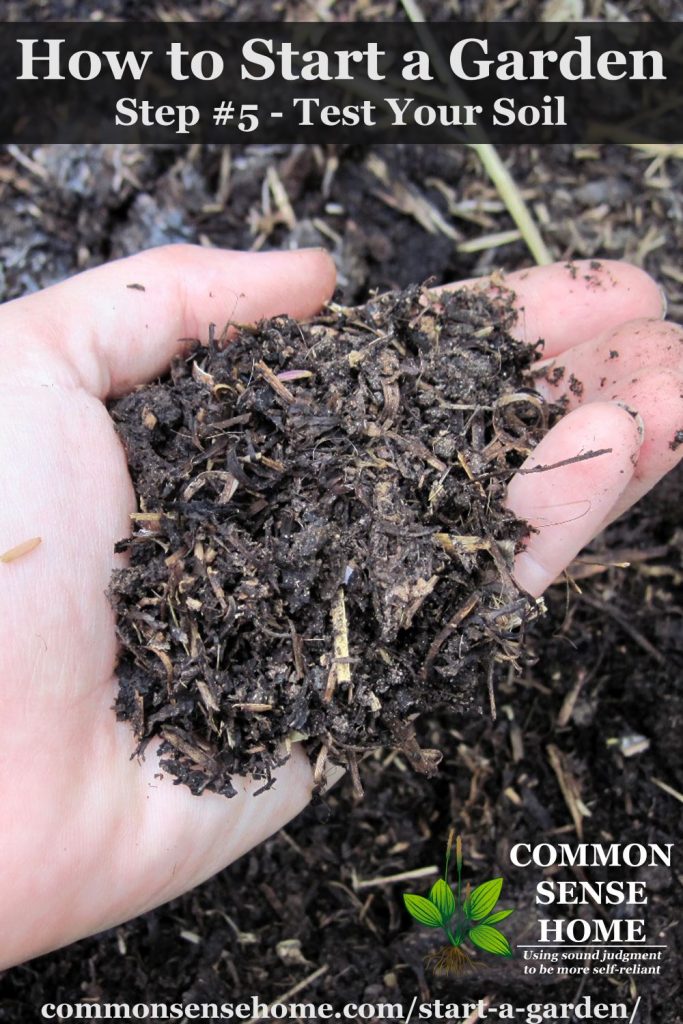
#5 – Test Your Soil
Before you start building your garden beds or planting, you need to know something about your garden soil.
Is your soil acidic, alkaline or neutral pH? Do you have sand, clay, silt, rocks, or a mix of all four? Is there a risk of soil contamination from nearby structures, roadways or other sources? Does it have a good amount of basic nutrients?
Some of these characteristics can be determined just from looking at the soil. Others may require home tests or professional lab tests. For instance, lead contamination from old house paint or nearby roadways with heavy traffic is a problem in some areas.
Most garden crops prefer soil with a pH around 7 (neutral), although some like conditions that are slightly acidic (potatoes, for instance) or slightly alkaline (brassicas). Balanced nutrient levels are also important, as is the presence of organic matter.
See "Soil Testing – 5 Easy Tests for Your Yard and Garden" for easy home test options. In the U.S., you can also contact your local cooperative extension office for advice.
#6 – Build Your Soil
If you're starting with sod, you'll either need to cut it up in chunks and repurpose it, till it in, or lay down wet newspaper or cardboard to smother it and build a bed on top. Preparing in fall is best, but don't let that stop you from starting in spring.
Most plants prefer a deep, well-drained, fertile soil rich in organic matter. Plant roots need good garden soil to produce good vegetables and fruit.
Once you start a garden, you'll gain a new appreciation for healthy soil as it improves year after year. Healthy, vibrant soil = healthy, vibrant plants with built in disease and pest resistance and more nutrition.

Each year I add a combination of different types of organic matter, including compost, worm castings and mulch. You can learn more about soil building in the post, "Feed Your Plants, Soil and Microbes".
#7 – Choose the Right Seeds or Transplants
My favorite seed sources can be found in the article, "10 Heirloom Seed Companies You Don't Want to Miss". Dave's Garden Watch Dog is a great place to check out a company before you order from them.
To learn which plants grow best directly seeded in the garden and which plants are better as transplants, visit the seed starting calendar. If you want to grow specific varieties, especially heirloom varieties, you'll probably need to grow your own transplants from seed. Starting your own transplants is a great way to save money, too.
You can view my seed starting setup and more detailed information on tomato transplants in Grow Tomatoes from Seed – Save Money, Get More Varieties.
If you're not ready to tackle growing transplants for your garden, here are some tips to help you spot the best plants at the nursery:
- Look for pots that are roughly equal in size to the plant. Big plants in tiny pots are more likely to be root bound (with roots tangled and growing in circles inside the pot) and suffer from transplant shock when planted in the garden.
- Watch for signs of stress such as insect damage or yellow leaves. Many stores now set up seasonal plant sales in their parking lots. Even with regular watering, baking asphalt is hard on seedlings.
- Ask whether or not your plants or seeds were treated or sprayed with potentially harmful chemicals such as neonicotinoid pesticides. Pollinators are critical for fruit set in the garden, so you don't want to buy plants that may harm them.
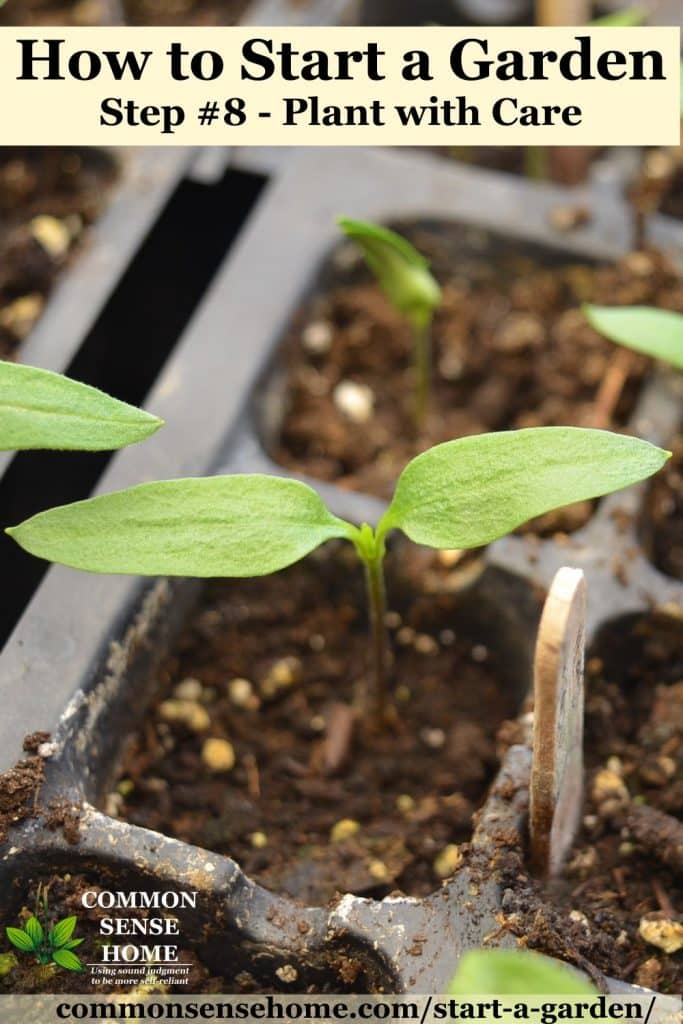
#8 – Plant with Care
Most seed packets and transplant containers come with basic planting instructions. Once you've done the ground work (literally), you just need to jump in and plant. Just give it a try and you can learn the rest as you go.
Rules of thumb for planting in your garden:
- Plant seeds roughly 3 times as deep as the diameter of the seed, unless otherwise directed on the package. Some seeds require light for germination.
- For transplants – most transplants are planted at the same depth they were growing in the pot. The exception is tomatoes, which can be planted deeper or trenched in. See "How to Grow (Lots of) Tomatoes Organically".
- Wait until danger of frost is past to plant heat loving plants such as tomatoes, peppers, cucumbers, okra, etc.
- Young plants are easier to damage than older plants, so they may need protection or hardening off when they are planted outside.
We have printable calendars to help you plan your seed sowing in the article, "When Should I Start My Seeds? Printable seed starting calendar". The 5-Minute Gardener: How to Plan, Create, and Sustain a Low-Maintenance Garden is a good reference for those who are short on time.
You can also click here or on the image below to get this handy pdf excerpted from the USDA school garden program that shows planting depth, plant spacing, days to germination and days to harvest for a variety of common garden crops.
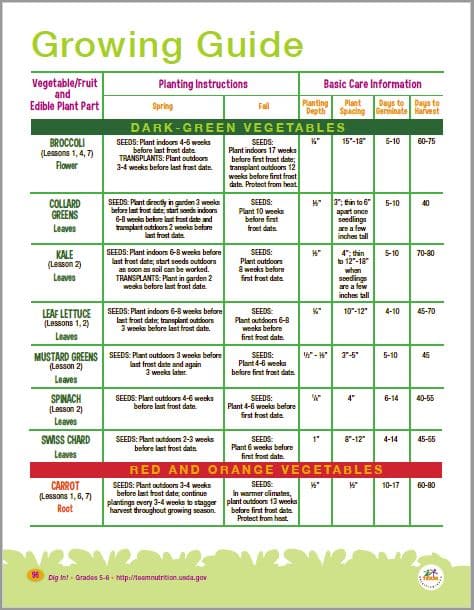
#9 – Nurture Your Garden
There's an old saying that says, "The best fertilizer is the gardener's shadow." If you're not prepared to make time in your schedule to tend to your plants, you may be better off hitting the farmer's market, or sticking with extremely low maintenance items like sprouts or herbs. Depending on the size of your plantings, time requirements may range from a few minutes per day to a full time job.
Nab weeds when they're small with a scuffle hoe – or use them as groundcover, food or medicine.
A rule of thumb for watering is that plants need around one inch of water per week during the growing season.If rains fail, you'll need to water your garden.
Over watering is as bad as under watering, so always check the soil before turning on a tap or hitting the rain barrels. Soil that is too wet can cause seeds and roots to rot. Foliar feeds like compost tea can be added to give plants extra nutrition and a dose of healthy microbes while watering.
Bugs are more attracted to plants that are stressed or in some way deficient. If you have healthy, well-nourished plants, your pest problems should be minimal. For most problems, there's an organic solution. If you're going through all the effort to grow your own food, why would you want to put toxins on it?
For more detailed information on controlling everything from slugs to rabbits, check out Natural Pest Control in the Garden.
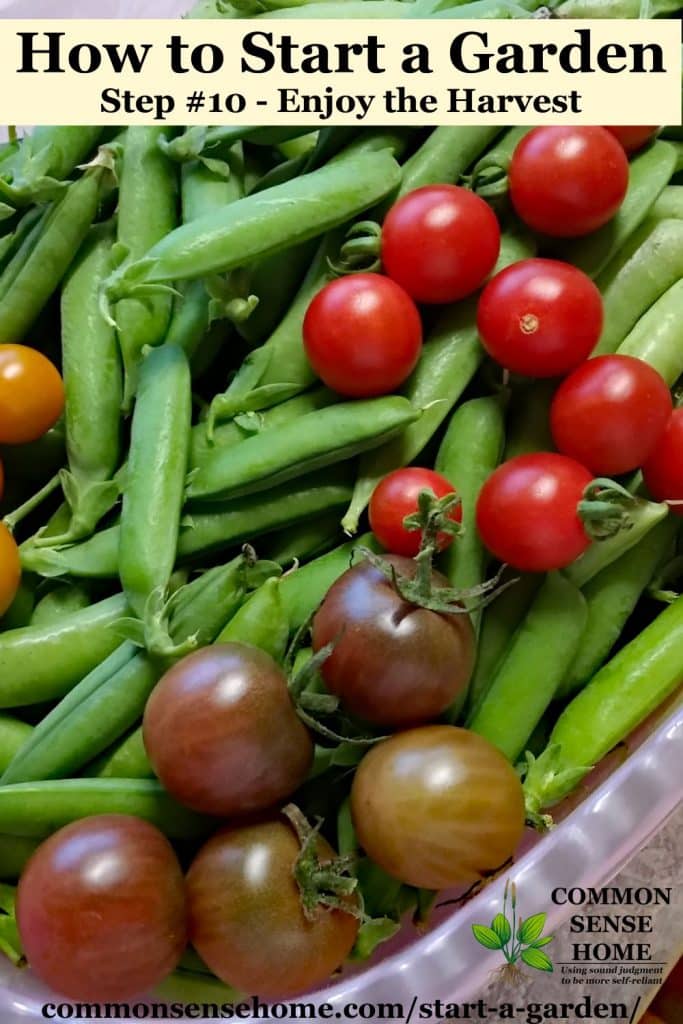
#10 – Enjoy Your Harvest
As crops mature, make sure to harvest promptly for best quality. Leafy greens like lettuce are typically "cut and come again", which means you can clip off the leaves and they will regrow for another harvest.
Pick beans and peas every two to three days. Harvest sweet corn when cobs are well filled out and silk is dark. Harvest tomatoes and peppers green, or allow them to ripen to full sweetness and flavor.
Flavor is typically at a peak when the morning dew has cleared, but before the afternoon heat has settled in. Sample and decide what tastes best to you. See How to Grow and Cook Nutrient Dense Foods for harvesting and storing tips.
One of the reasons I love gardening is because if things don't work out right the first time, there's always next year. There are dozens of different ways to do just about everything, but you won't know what works best for you and your garden until you try. If a plant/crop does poorly the first time you plant it, try again. I usually try a crop for at least three years before I give up on it, because different varieties grow best under different conditions.
Gardening is also good for your health. It can fight depression, reduce stress and improve your diet. See "Dirt Therapy – 8 Reasons You Need to Have a Garden" for more information.
More Gardening Information
I invite you to visit the Common Sense Gardening page for a full listing of more than 80 gardening posts on the website. There's advice on everything from seed starting to preserving the harvest.
You can also use the form below to join our newsletter list and get our Free Gardening Journal Templates AND a discount on our new course "Gardening for Beginners: The Common Sense Way to Grow Your Own Food".
Still have questions about how to start a garden? Leave a comment and I'll do my best to help.
Some of most popular gardening articles include:
- Too Much Rain in the Garden – Managing Wet Dirt and Waterlogged Plants
- Potato Towers – Which Varieties to Grow and Other Tips for Success
- Raised Garden Beds – 5 Tips for Surefire Success
- Growing Blueberries – Quick Guide and Master Growers Tips
- Put Your Weeds to Work – 5 Reasons I Want Weeds in My Garden
P. S. – Don't forget – We're working on a brand new gardening course for beginning gardeners! Make sure to sign up for the newsletter below to get notified when it's released. Newsletter subscribers also get a special discount on the course!
Originally published in 2012, last updated in 2021.
How Yo Make Garden Gate
Source: https://commonsensehome.com/start-a-garden/
Posted by: blunthaideatel.blogspot.com

0 Response to "How Yo Make Garden Gate"
Post a Comment